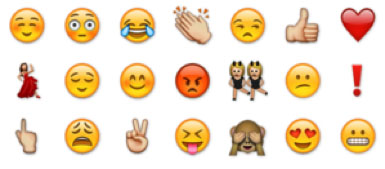How many times have you had to clarify the meaning of a text message to or from a spouse, friend, co-worker, etc.?
If I had a dollar for every time I replied to a text or email from someone with “Wait, are you joking or being serious?” I would have enough money to move to California and own my own winery (#lifegoals).
SMS (short message service) messaging has been widely used for the past 20+ years. But, while it may be much more convenient to quickly type out a message and press send without picking up the phone or going to talk to someone face to face, there are some important aspects of communication that cannot be substituted with plain text.
Lack of verbal and non-verbal cues from the sender can make for a very confusing exchange for the receiver, and as someone who speaks sarcasm as a second language, this can be a problem.
 In face to face communication, when I make a sarcastic comment, it is usually accompanied by an exaggerated facial expression such as a smirk or eye roll. Without cues via body language, gestures, facial expressions, or tone of voice, it can be very hard to decipher whether or not I am being serious or facetious via SMS, leaving the receiver to interpret my message to the best of their ability.
In face to face communication, when I make a sarcastic comment, it is usually accompanied by an exaggerated facial expression such as a smirk or eye roll. Without cues via body language, gestures, facial expressions, or tone of voice, it can be very hard to decipher whether or not I am being serious or facetious via SMS, leaving the receiver to interpret my message to the best of their ability.
When trying to understand meaning, we use ourselves as a point of reference when it comes to imagining the feelings, perspective, or thoughts of someone else. This can lead to dramatic overestimation of how accurately we are interpreting the meaning the sender was trying to convey and, in turn, lead to misunderstanding. But, in a world where we are constantly communicating via social platforms such as Facebook, Instagram, Twitter, etc., it was only a matter of time before we started to find creative ways to avoid these misinterpretations.
These days, the word “literally” is used so out of context that it literally has become socially recognized to mean the antithesis of the original definition, and “Okay,” “Ok,” and “K” can stand for 3 separate emotions stemming from one word. It is clear that the way we use language to communicate is evolving and if acronyms popularized by SMS such as “lol” and “smh” weren’t enough, now we have small cartoon-like pictures, known as emojis, as another way to express our thoughts and feelings without using actual words.
Using pictures to portray feelings, objects, or ideas is nothing new though. A concept that has been used by ancient cultures throughout the ages, such as Native American cave paintings and Egyptian hieroglyphs, is still just as relevant now as we interpret symbols on a daily basis. While certain symbols may not accurately translate across all cultures, facial expressions in response to specific feelings surpass language barriers. For example, at many hospitals, pain is assessed using the Wong-Baker FACES Pain Rating Scale where a patient points to the face that most accurately describes their level of pain or discomfort. This is because the feeling associated with each facial expression is not decided by individual ideology, but rather it is a socially constructed idea that translates universally.
While I’m not advocating that they should be used in a professional setting, I do think emojis can be a fun and convenient way of reducing ambiguity. When used properly, they can serve in place of the verbal and non-verbal cues a receiver would normally rely on in face to face communication in order to have a relevant response. So, while some may feel using acronyms and emojis to communicate only furthers the cultural gap between millennials and generations before, the reality is that using pictures to convey a message is more rooted in the art of communication than you may think.

